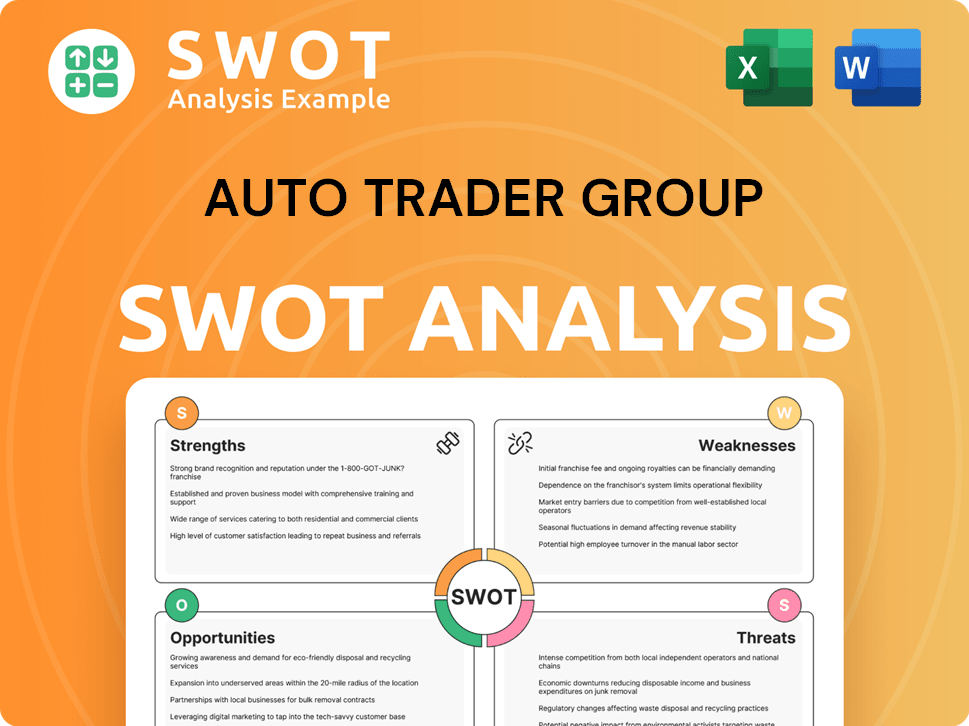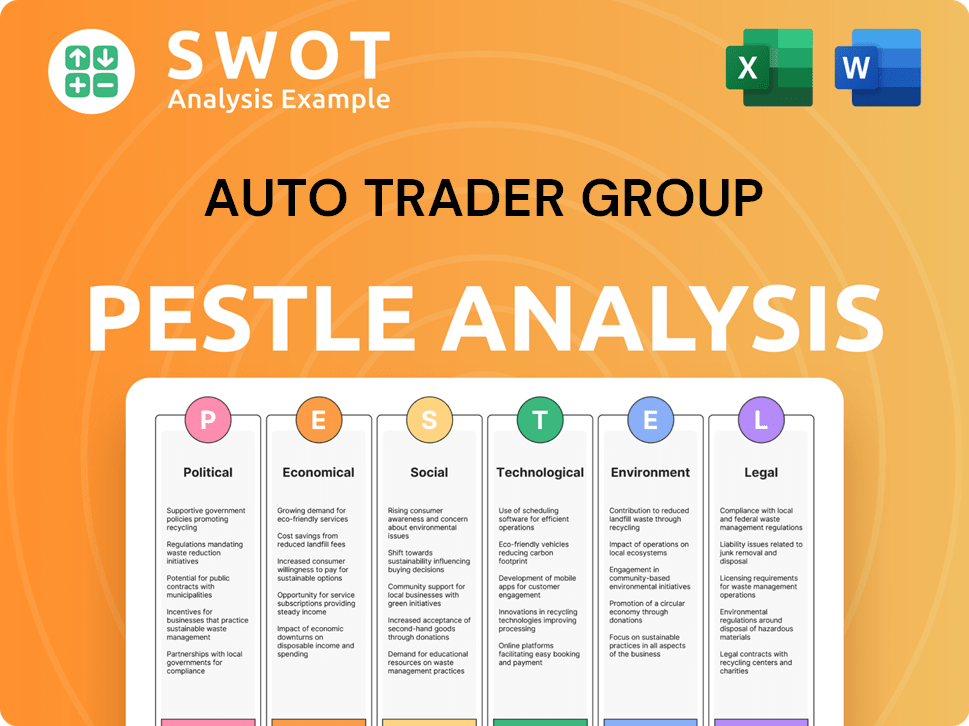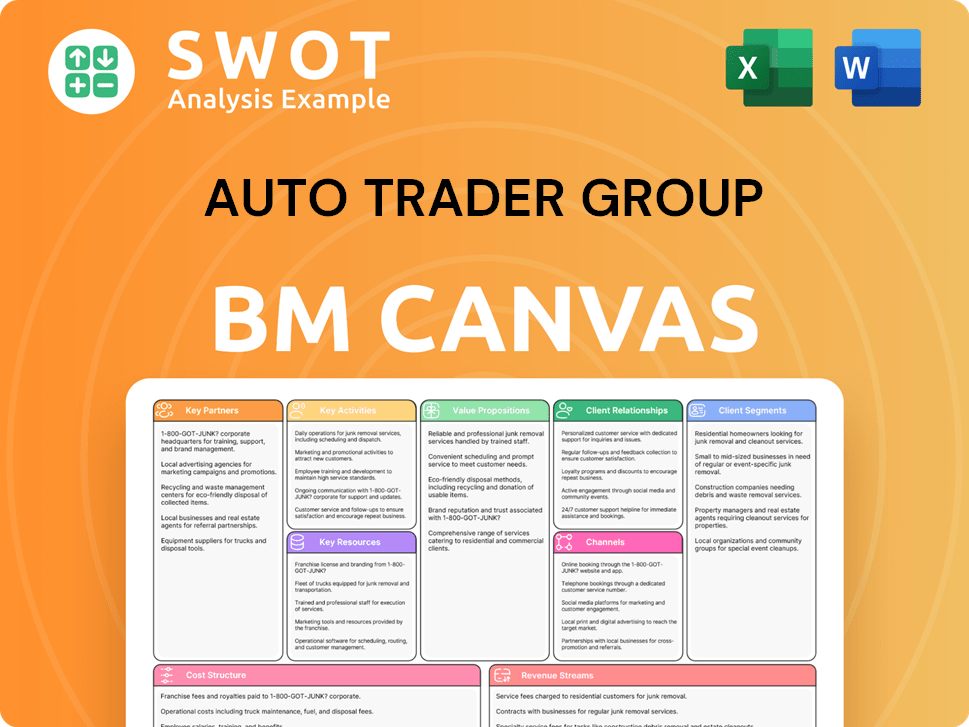Auto Trader Group Bundle
Can Auto Trader Group Maintain its Dominance in the Evolving Car Market?
The automotive industry is experiencing a seismic shift, and at the forefront of this transformation is Auto Trader Group, the UK's leading Auto Trader Group SWOT Analysis. From its origins as a print magazine, Auto Trader has become a powerhouse in the online automotive marketplace. With a massive digital footprint and millions of users, the company's journey is a compelling case study in digital transformation and strategic growth.

This analysis dives deep into Auto Trader Group's growth strategy, exploring its expansion plans and the impact of digital advertising on car sales. We'll examine its innovative approach to the used car market trends and dealer partnerships, providing insights into its long term growth prospects. Understanding Auto Trader Group's business model, competitive landscape, and customer acquisition strategies is crucial for anyone seeking to understand the future of this online automotive marketplace and its investment opportunities.
How Is Auto Trader Group Expanding Its Reach?
The Revenue Streams & Business Model of Auto Trader Group is actively pursuing several expansion initiatives to bolster its market position and diversify its income sources. These efforts are centered on enhancing its digital retailing strategy, particularly through products like 'Deal Builder'. This strategy is critical for the company's future growth.
A key focus is on enhancing its digital retailing strategy, with products like 'Deal Builder' playing a crucial role. Deal Builder, which allows car buyers to value part-exchanges, apply for finance, and reserve cars online, has seen significant scaling.
The company is adapting to structural changes in the new car market, which has seen growth driven by the fleet channel, and a shift in consumer behavior away from brand loyalty, especially with the influx of new electric vehicle (EV) brands. Auto Trader is well-placed to support these changes.
Deal Builder has been a major focus, with its availability growing rapidly. By the end of March 2025, the service was available to approximately 2,000 retailers, a significant increase from around 1,100 in March 2024. This expansion is a core part of their digital retailing strategy.
The number of deals facilitated by Deal Builder has shown substantial growth. The number of deals generated through Deal Builder tripled from approximately 16,000 in 2024 to about 49,000 in 2025. This growth highlights the increasing adoption and effectiveness of the platform.
To accelerate retailer adoption and enhance car buyer engagement, Deal Builder functionality is being integrated into the core advertising proposition. This strategic move aims to make the platform even more accessible and user-friendly.
The company is also adapting to structural changes in the new car market. This includes supporting franchise retailers, manufacturers, and leasing companies in selling new cars directly to consumers on its platform. This adaptation is crucial for maintaining relevance.
The company is heavily invested in the transition to electric vehicles, aiming to be the premier EV destination in the UK. They are also actively influencing government policies to promote EV adoption. This strategic focus is critical for long-term growth.
- Launching e-bikes on its marketplace to expand its offerings.
- Engaging over 10.8 million people monthly through its EV giveaway campaign.
- Developing products for franchise retailers, manufacturers, and leasing companies.
- Supporting the shift in consumer behavior towards EVs.
Auto Trader Group SWOT Analysis
- Complete SWOT Breakdown
- Fully Customizable
- Editable in Excel & Word
- Professional Formatting
- Investor-Ready Format

How Does Auto Trader Group Invest in Innovation?
The Auto Trader Group's sustained growth is significantly driven by its continuous investment in technology and innovation, particularly in artificial intelligence (AI). This focus allows the company to adapt to the evolving needs of both car buyers and retailers in the online automotive marketplace.
The company's strategic emphasis on technology and innovation is evident in its development of AI-driven features designed to enhance both retailer efficiency and the car buyer experience. This approach is crucial for maintaining a competitive edge in the digital advertising and car sales sectors.
The company's in-house team of over 400 data scientists and engineers has developed 'Co-Driver,' a suite of AI-enabled features designed to enhance both retailer efficiency and the car buyer experience. Co-Driver, launched in 2025, automates tasks such as image sequencing, generating descriptions, and highlighting vehicle features, drastically reducing the time it takes for retailers to create adverts from an average of 28 minutes to approximately five.
By February 2025, Co-Driver had reordered 9 million vehicle images across 290,000 listings.
Co-Driver generated 285,000 AI-powered descriptions, with a 96% acceptance rate by retailers.
Nearly 10,000 sites now use Co-Driver, demonstrating its widespread adoption.
The company's 'Trended Valuations' and 'Retail Check' modules are part of its Auto Trader Connect offerings.
The company delivered 89,000 software releases in 2025, an increase from 65,000 in 2024.
The company continues to leverage its industry-leading technology and data platform to bring more of the car buying journey online.
These innovations are critical for the company's long term growth prospects. Auto Trader's investment in AI and data-driven tools, such as 'Trended Valuations' and 'Retail Check,' empowers retailers to optimize pricing and margins. The high-velocity approach to software development, with 89,000 releases in 2025, showcases the company's commitment to continuous improvement and adaptation in the dynamic car sales market.
The company's technology strategy focuses on enhancing the car buying experience for consumers and enabling retailer partners to sell vehicles more efficiently.
- AI-powered features like Co-Driver automate tasks and reduce advert creation time.
- Data-driven tools such as 'Trended Valuations' and 'Retail Check' optimize pricing.
- High-velocity software development ensures continuous improvement and adaptation.
- Focus on bringing more of the car buying journey online.
Auto Trader Group PESTLE Analysis
- Covers All 6 PESTLE Categories
- No Research Needed – Save Hours of Work
- Built by Experts, Trusted by Consultants
- Instant Download, Ready to Use
- 100% Editable, Fully Customizable

What Is Auto Trader Group’s Growth Forecast?
The financial outlook for Auto Trader Group remains positive, underpinned by robust performance and strategic initiatives. The company's focus on the Auto Trader Future involves sustained investments in digital advertising and car sales platforms. This approach supports its Growth Strategy and strengthens its position in the Online Automotive Marketplace.
For the fiscal year ending March 31, 2025, Auto Trader Group reported significant financial gains. Revenue increased by 5%, surpassing £600 million, while the Group operating profit rose by 8%, reaching £376.8 million. These figures reflect the company's ability to capitalize on market trends and enhance its operational efficiency. Basic earnings per share (EPS) also saw a substantial increase of 12%.
Core Auto Trader revenue grew by 7% to £564.8 million, with operating profit before Digital Services Tax increasing by 7%. The operating profit margin for the Group improved to 63% in FY25, a 2-percentage-point increase from FY24, while AutoTrader.co.uk's operating profit margin held steady at 70%. Average Revenue Per Retailer (ARPR) per month increased by 5% to £2,854 in FY25, driven by contributions from pricing and product initiatives.
The company's revenue increased by 5%, exceeding £600 million, demonstrating a strong performance in the Digital Advertising and car sales sectors. This growth is a key indicator of the company's success in the Car Sales market.
Group operating profit increased by 8%, reaching £376.8 million. This increase reflects improved operational efficiency and strategic investments. The company's ability to maintain a high operating profit margin is a positive sign for investors.
Average Revenue Per Retailer (ARPR) per month increased by 5% to £2,854 in FY25. This growth is driven by pricing and product initiatives, showing the effectiveness of the company's strategies. This growth is a key indicator of the company's success in the Car Sales market.
Auto Trader Group returned £275.7 million to shareholders in 2024 through share buybacks and dividends. A final dividend of 7.1 pence per share for FY25 was proposed, bringing the total dividend to 10.6 pence per share, an 11% increase from 2024. This demonstrates the company's commitment to Auto Trader Group returning value to its shareholders.
Despite challenges in new car leasing deliveries due to supply constraints, Auto Trader is focused on reducing losses in its Autorama leasing business, with expectations for stabilization by 2026. The company anticipates continued ARPR growth in the new financial year, with price growth of £90-£100, product growth of £120-£130, and stock growth of £20-£40. The company's robust cash flow and net cash position of £15.3 million in FY25, a significant improvement from a net debt of £11.3 million in FY24, underpin its financial flexibility. For more details, consider reading about Owners & Shareholders of Auto Trader Group.
The company's net cash position improved significantly to £15.3 million in FY25, from a net debt of £11.3 million in FY24. This financial flexibility supports future investments and strategic initiatives.
Auto Trader Group returned substantial value to shareholders through dividends and share buybacks. The proposed final dividend for FY25 reflects the company's commitment to returning value to its shareholders.
ARPR growth is driven by pricing and product initiatives, indicating the effectiveness of the company's strategies. Continued ARPR growth is anticipated in the new financial year.
The improvement in operating profit margin to 63% in FY25, a 2-percentage-point increase from FY24, demonstrates enhanced operational efficiency. This increase reflects improved operational efficiency and strategic investments.
The company is focused on reducing losses in its Autorama leasing business, with expectations for stabilization by 2026. This strategic focus is a key element of the Auto Trader Future.
The company's strong financial performance reinforces its leading position in the Online Automotive Marketplace. This solidifies its Growth Strategy and its ability to navigate market dynamics.
Auto Trader Group Business Model Canvas
- Complete 9-Block Business Model Canvas
- Effortlessly Communicate Your Business Strategy
- Investor-Ready BMC Format
- 100% Editable and Customizable
- Clear and Structured Layout

What Risks Could Slow Auto Trader Group’s Growth?
The Auto Trader Group faces several risks that could affect its growth strategy and future prospects. These challenges span market dynamics, regulatory changes, and technological advancements. Understanding these potential obstacles is crucial for evaluating the company's long-term viability and investment opportunities in the online automotive marketplace.
Competition, economic conditions, and the pace of technological change are key areas of concern. While the company maintains a strong position, being more than 10 times larger than its nearest competitor, external factors can still influence car sales and advertising revenue. The company's ability to adapt to these challenges will be critical for sustained success.
The company's strategic and operational risks can be categorized into several key areas. These include market competition, regulatory changes, supply chain vulnerabilities, and the impact of economic conditions on consumer demand. The company must also manage the risks associated with technological disruption and internal resource constraints.
The Auto Trader Group operates in a competitive market, though it holds a dominant position. The company's ability to maintain its market share and attract new customers is crucial for its growth strategy. Continuous innovation and adaptation are necessary to stay ahead of competitors in the online automotive marketplace.
Regulatory changes can directly impact the company's financial performance. For example, the UK's Digital Services Tax resulted in a £10.2 million charge to operating expenses in FY25. The company must navigate evolving regulations to minimize financial and operational impacts.
Fluctuations in consumer demand and interest rates can affect car sales and retailer profitability. These conditions can subsequently reduce advertising spend with Auto Trader Group. The company must be prepared for economic downturns and adapt its strategies accordingly.
The automotive industry is undergoing significant technological changes, including the rise of direct and digital sales channels. Auto Trader Group must continuously invest in AI and data-driven solutions to remain relevant. Staying ahead of these changes is critical for long-term success.
Supply chain issues can impact the availability of new and used vehicles, which can affect the company's advertising revenue. Managing these vulnerabilities requires strong relationships with dealers and a flexible business model. The company must adapt to supply chain disruptions to maintain its performance.
Maintaining high employee engagement is essential for the company's success. Employee engagement was at 91% in March 2025, down from 97% in March 2024. The company must manage its internal resources effectively to ensure continued innovation and growth. Understanding the Target Market of Auto Trader Group is also crucial for aligning internal resources with customer needs.
The company employs a four-step risk management process: identifying, assessing, mitigating, and monitoring risks. Regular reviews by the PLC Board ensure that risks are continuously evaluated and addressed. This framework is essential for protecting the company from potential threats and ensuring sustainable growth.
Product innovation can present significant opportunities but also carries financial risks. The company is flexible in taking risks related to product development and addressing competitive threats. This proactive approach allows Auto Trader Group to adapt to market changes and maintain its competitive edge.
Auto Trader Group Porter's Five Forces Analysis
- Covers All 5 Competitive Forces in Detail
- Structured for Consultants, Students, and Founders
- 100% Editable in Microsoft Word & Excel
- Instant Digital Download – Use Immediately
- Compatible with Mac & PC – Fully Unlocked

Related Blogs
- What are Mission Vision & Core Values of Auto Trader Group Company?
- What is Competitive Landscape of Auto Trader Group Company?
- How Does Auto Trader Group Company Work?
- What is Sales and Marketing Strategy of Auto Trader Group Company?
- What is Brief History of Auto Trader Group Company?
- Who Owns Auto Trader Group Company?
- What is Customer Demographics and Target Market of Auto Trader Group Company?
Disclaimer
All information, articles, and product details provided on this website are for general informational and educational purposes only. We do not claim any ownership over, nor do we intend to infringe upon, any trademarks, copyrights, logos, brand names, or other intellectual property mentioned or depicted on this site. Such intellectual property remains the property of its respective owners, and any references here are made solely for identification or informational purposes, without implying any affiliation, endorsement, or partnership.
We make no representations or warranties, express or implied, regarding the accuracy, completeness, or suitability of any content or products presented. Nothing on this website should be construed as legal, tax, investment, financial, medical, or other professional advice. In addition, no part of this site—including articles or product references—constitutes a solicitation, recommendation, endorsement, advertisement, or offer to buy or sell any securities, franchises, or other financial instruments, particularly in jurisdictions where such activity would be unlawful.
All content is of a general nature and may not address the specific circumstances of any individual or entity. It is not a substitute for professional advice or services. Any actions you take based on the information provided here are strictly at your own risk. You accept full responsibility for any decisions or outcomes arising from your use of this website and agree to release us from any liability in connection with your use of, or reliance upon, the content or products found herein.